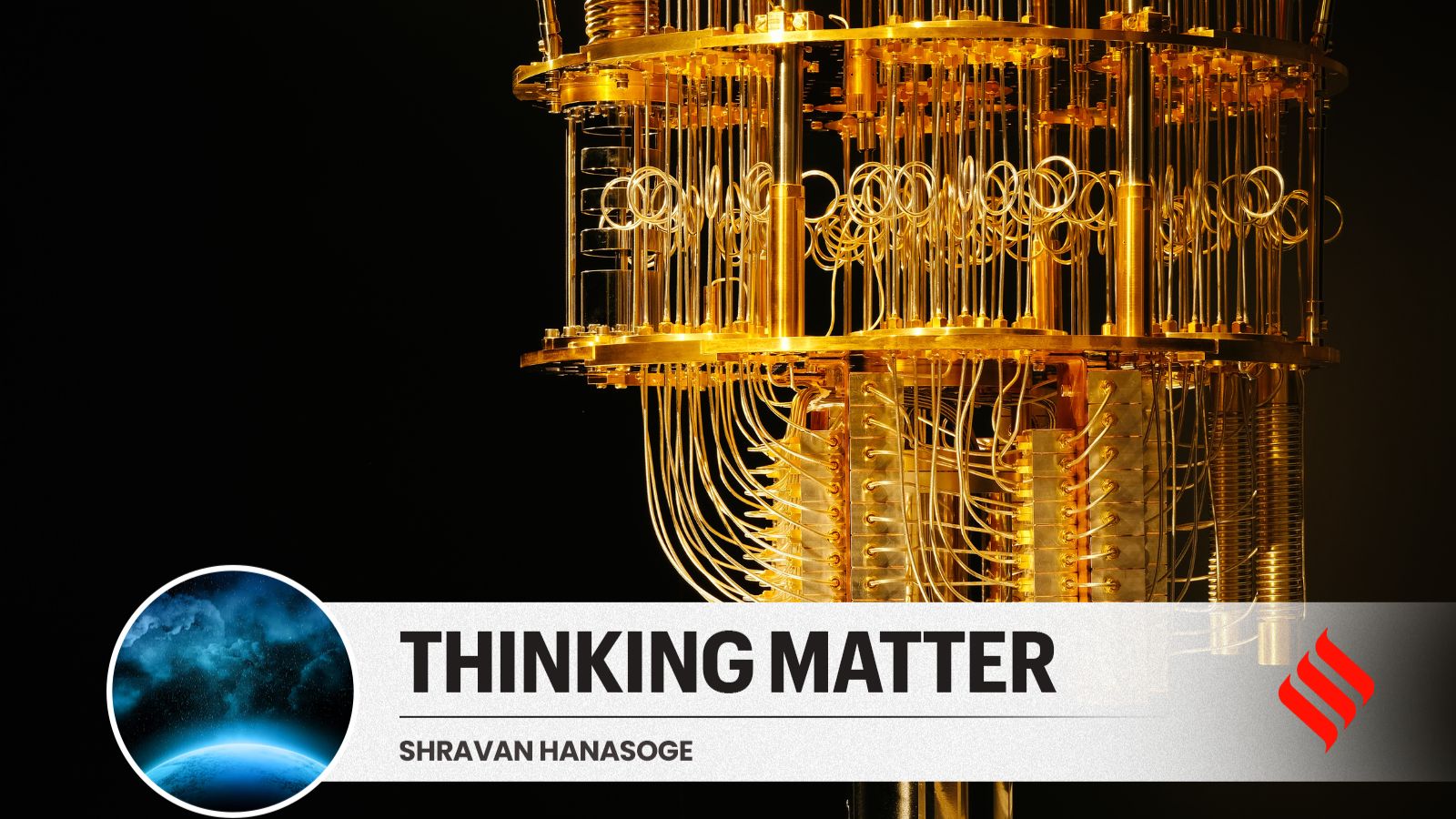“Nature isn’t classical, dammit; and if you want to make a simulation of nature, you’d better make it quantum mechanical.” — Richard Feynman, 1981
With that blunt provocation, the legendary physicist threw down a gauntlet that still challenges science today. If the universe runs on the strange rules of quantum mechanics — with particles existing in multiple states at once and influencing each other instantaneously across space — why are we using computers built on classical logic to understand it? Wouldn’t a quantum world be best understood by a quantum machine?
That simple idea planted the seed for one of the most radical technologies in the making: the quantum computer. But first, how we got to that point.
For much of the 20th century, computing meant tinkering with mechanical contraptions — from slide rules and punch cards to room-sized mainframes wired with vacuum tubes. These machines solved problems by following step-by-step instructions, manipulating electric signals or gears to simulate logic and arithmetic.
The real revolution came in the 1950s, with the arrival of digital computing. Suddenly, everything could be broken down into bits, tiny switches that could be either on (1) or off (0). These humble 0s and 1s gave us a universal language: one machine, given the right code, could simulate anything from weather patterns to word processors.
As these digital systems grew in power, scientists naturally wondered: how far could this go? Could we simulate the behavior of nature itself — atoms, molecules, and the building blocks of reality? That’s when they hit a wall. Classical computers, no matter how fast, struggled to model the weirdness of quantum systems. Every additional particle increased the complexity. Even the most powerful supercomputers couldn’t keep up.
That is when Feynman posed his provocative question: if nature is quantum mechanical, why are we trying to simulate it with classical machines? What if we built a computer that itself obeyed the rules of quantum physics?
Story continues below this ad
To understand that vision, we need to grasp how quantum objects differ from the familiar ones around us. A classical object — a coin, a car, a bit in your laptop — has definite properties that can be measured without changing them. A quantum object, like an electron or a photon, behaves differently. It can exist in a superposition of states; meaning it can be in multiple configurations at once, and its properties become definite only when observed. What’s more, it can be entangled with others, so that measuring one instantly affects the other, no matter how far apart they are.
These strange behaviors aren’t just curiosities. They’re powerful. If harnessed correctly, they could unlock new kinds of computation — not just faster, but fundamentally different. That was Feynman’s vision: a machine that speaks nature’s own language.
Harnessing superposition and entanglement
The Heisenberg uncertainty principle, part of the bedrock of quantum mechanics, tells us that certain pairs of properties — such as position and momentum — cannot both be known exactly at the same time. This fuzziness gives rise to superposition, where a quantum system exists in a blend of states simultaneously.
For a qubit, superposition means it can be 0 and 1 at once, like a spinning coin undecided until it lands. Only upon measurement does its state “collapse” into either 0 or 1, enabling parallel exploration of possibilities.
Story continues below this ad
Even more astonishing is entanglement, a uniquely quantum link between qubits. When qubits become entangled, their individual states have no independent meaning; you can only describe the system as a whole. Measuring one qubit instantly determines its partner’s state, no matter the distance between them — a phenomenon Albert Einstein dubbed “spooky action at a distance.”
How to tame a qubit
The challenge is to harness the potential of the quantum states for use in computing. Quantum states are exquisitely fragile. Tiny disturbances — thermal vibrations, stray fields, or cosmic rays — can collapse superpositions in a process called decoherence. Today’s qubits remain coherent for just 10⁻⁵ to 10⁻⁴ seconds before errors arise, whereas classical memory holds data intact for milliseconds to years.
To combat decoherence, researchers therefore cool qubits to near absolute zero, isolate them in vacuum, and use error-correction schemes that trade many physical qubits for one robust “logical” qubit. These logical qubits can detect and correct small quantum errors on the fly, preserving the fragile quantum information long enough for useful computation.
Despite these hurdles, milestone demonstrations have arrived. In 2019, Google’s Sycamore processor executed a special sampling task in 200 seconds — an operation estimated to take a classical supercomputer 10,000 years. While that benchmark had no immediate practical use and was a contrived problem, it proved the principle of “quantum advantage.”
Story continues below this ad
Since then, other companies and research groups have made steady progress: IBM has built devices with over 100 qubits and is pursuing a 1,000-qubit machine; China’s Jiuzhang photonic quantum computer has performed similar advantage demonstrations using light; and startups like IonQ and PsiQuantum are exploring alternative qubit architectures with an eye on scalability.
Quantum: Promise and Peril
# If successfully developed, quantum computers could transform industries across the board. In pharmaceuticals and materials science, they could revolutionize molecular design by simulating chemical reactions and protein folding with atomic precision, paving the way for faster drug discovery and novel materials.
# In logistics, transportation, and finance, quantum optimization algorithms could deliver vastly improved solutions for traffic management, supply chain efficiency, and portfolio risk balancing.
# In the field of cybersecurity, quantum communication promises virtually unhackable networks through quantum key distribution, a technology already being tested in several countries.
Story continues below this ad
# High-precision sensing, enabling ultraprecise clocks, gravity detectors for mineral exploration, and next-generation medical imaging.
They could also threaten today’s security. Shor’s ( quantum) algorithm can factor large numbers exponentially faster than classical methods, putting public-key systems (RSA, ECC) that secure internet banking, e-commerce, and government communications at risk. When large, error-corrected quantum computers arrive, they could decrypt decades of digital traffic overnight. This has spurred a global push toward post-quantum cryptography, new codes believed safe even against quantum attacks.
Effective storage today
A nominal 100-qubit system can, in theory, represent 2¹⁰⁰ (≈1×10³⁰) states simultaneously, requiring some 10³¹ numbers to emulate on a classical machine. Yet with current error rates and no full error correction, those 100 physical qubits effectively yield fewer than 5 fully reliable logical qubits – enough to hold only 2⁵=32 basis states in superposition. By contrast, a typical laptop’s 1 TB drive stores about 8×10¹² classical bits reliably for years.
Today’s devices host tens to a few hundred qubits but suffer from limited coherence and high error rates, so only small-scale algorithm demonstrations are possible.
Story continues below this ad
Global race for quantum computing
The total public and private investment in quantum technologies has surpassed US $55 billion over the last decade. China leads with over $15 billion in public spending, the U.S. follows with about $4 billion, and the EU’s €1 billion Quantum Flagship rounds out the top three. Each nation seeks both technological leadership and safeguards against quantum-enabled threats.
In India, the 2020 National Quantum Mission committed ₹8,000 crore (≈US $1 billion) over five years. Research groups at the IITs, IISc, and TIFR, along with several startups, operate 5–10-qubit systems today and aim for 50–100 qubits by 2030 — enough to begin tackling more complex problems and cement India’s role in the quantum ecosystem. India’s initial funding injection places it among the top five investors, alongside the U.K., Canada, and Japan.
Looking Ahead
A fully fault-tolerant quantum computer, with millions of physical qubits supporting error-corrected logical qubits, remains years or decades away. Yet the work today in improving qubit stability, scaling control electronics, and rolling out quantum-safe encryption lays the groundwork.
Quantum machines will not replace classical computers but will augment them, tackling specialised problems – the computationally toughest subroutines like simulating quantum materials, solving large-scale optimization problems, and breaking cryptographic codes – that classical systems struggle with. As this new paradigm matures, we stand on the brink of an era defined not by what’s possible with bits, but by what we can achieve with qubits.
Story continues below this ad
Shravan Hanasoge is an astrophysicist at the Tata Institute of Fundamental Research.





Average Rating